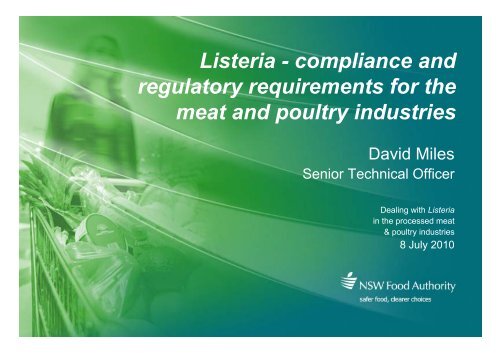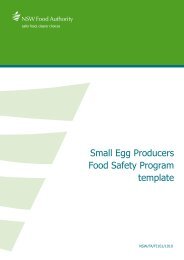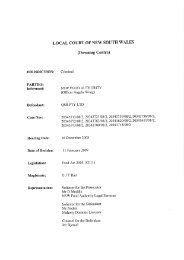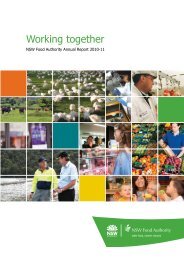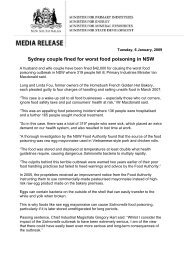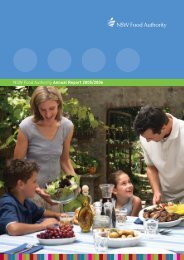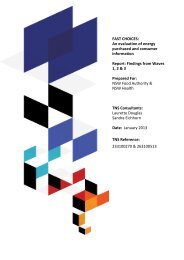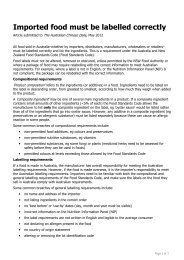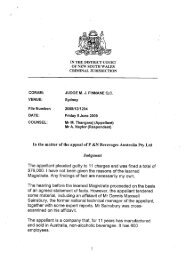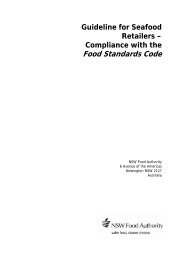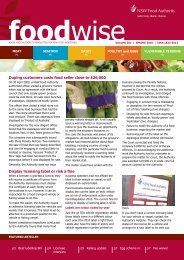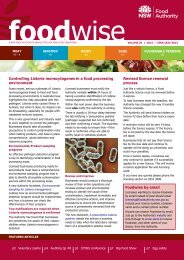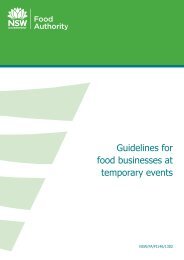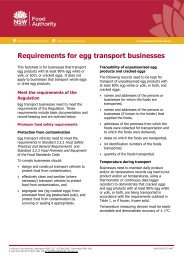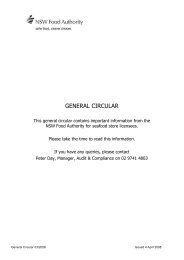Compliance and regulatory requirements for the meat and poultry ...
Compliance and regulatory requirements for the meat and poultry ...
Compliance and regulatory requirements for the meat and poultry ...
You also want an ePaper? Increase the reach of your titles
YUMPU automatically turns print PDFs into web optimized ePapers that Google loves.
Listeria - compliance <strong>and</strong><br />
<strong>regulatory</strong> <strong>requirements</strong> <strong>for</strong> <strong>the</strong><br />
<strong>meat</strong> <strong>and</strong> <strong>poultry</strong> industries<br />
David Miles<br />
Senior Technical Officer<br />
Dealing with Listeria<br />
in <strong>the</strong> processed <strong>meat</strong><br />
& <strong>poultry</strong> industries<br />
8 July 2010
Regulatory approach to control of<br />
Listeria monocytogenes<br />
• Risk assessment – basing regulation on science<br />
– FDA/USDA<br />
– FAO/WHO<br />
• Risk management - Australian regulations<br />
– Food St<strong>and</strong>ards Code<br />
– Guidelines<br />
• Risk management – <strong>meat</strong> industry specific <strong>requirements</strong><br />
– Listeria management program<br />
• Risk communication<br />
– Advice to pregnant women<br />
• Codex – microbiological criteria in RTE foods
Science-based regulation<br />
• International risk assessments have examined <strong>the</strong> public<br />
health risk from Listeria monocytogenes in great depth<br />
• FDA/USDA risk assessment (2003)<br />
– examined 23 ready-to-eat (RTE) foods<br />
– consumption data <strong>and</strong> prevalence data were combined<br />
with <strong>the</strong> potential <strong>for</strong> <strong>the</strong> food to support <strong>the</strong> growth of <strong>the</strong><br />
organism<br />
– foods were ranked according to:<br />
• risk per serving<br />
• risk per annum
Deli <strong>meat</strong>s were ranked<br />
as <strong>the</strong> highest risk food,<br />
estimated to cause over<br />
1500 (90% of total)<br />
listeriosis cases in <strong>the</strong><br />
USA each year<br />
Dry/semi dry fermented<br />
sausages were ranked<br />
as one of <strong>the</strong> lowest risk<br />
food - estimated to<br />
cause less than one<br />
case of listeriosis every<br />
10 years
International risk assessments<br />
• FAO/WHO (2004) - Risk assessment of Listeria<br />
monocytogenes in ready-to-eat (RTE) foods was developed to<br />
answer three specific questions:<br />
1. Estimate <strong>the</strong> risk of illness in food when <strong>the</strong> number of<br />
organisms ranges from ND - 1000 cfu/g, or does not exceed<br />
specified levels at <strong>the</strong> point of consumption<br />
2. Estimate <strong>the</strong> risk of illness in different susceptible population<br />
groups (elderly, infants, pregnant women <strong>and</strong><br />
immunocompromised patients) relative to <strong>the</strong> general<br />
population<br />
3. Estimate <strong>the</strong> risk of illness in foods that support its growth <strong>and</strong><br />
foods that do not support its growth at specific storage <strong>and</strong><br />
shelf-life conditions.
Q3 - Estimate <strong>the</strong> risk of illness in foods that support its growth<br />
<strong>and</strong> foods that do not support its growth at specific<br />
storage <strong>and</strong> shelf-life conditions.<br />
Risk estimates of <strong>the</strong> risk per serving <strong>for</strong> 4 RTE foods <strong>and</strong> estimated number of<br />
illness per 100 million people per year<br />
Food<br />
Milk<br />
Cases of listeriosis per<br />
1 million serves<br />
0.005<br />
Cases of listeriosis per<br />
10 million people per year<br />
9.1<br />
Ice cream<br />
0.000014<br />
0.012<br />
Smoked fish<br />
0.021<br />
0.46<br />
Fermented <strong>meat</strong>s<br />
0.0000025<br />
0.00066
Q2 - Estimate <strong>the</strong> risk of illness <strong>for</strong> consumers in<br />
different susceptible population groups<br />
Relative susceptibilities <strong>for</strong> different sub-population groups (based on French data)<br />
Condition<br />
Relative susceptibility<br />
Transplant<br />
2584<br />
Cancer-blood<br />
1364<br />
AIDS<br />
865<br />
Dialysis<br />
476<br />
Cancer-pulmonary<br />
229<br />
Cancer-gastrointestinal <strong>and</strong> liver<br />
211<br />
Non-cancer liver disease<br />
143<br />
Cancer-bladder <strong>and</strong> prostrate<br />
112<br />
Cancer-gynaecological<br />
66<br />
Diabetes, insulin dependent<br />
30<br />
Diabetes, non-insulin dependent<br />
25<br />
Alcoholism<br />
18<br />
Over 65 years old<br />
7.5<br />
Less than 65 years old, no o<strong>the</strong>r condition<br />
1
Q1 - Estimate <strong>the</strong> risk of illness in food when <strong>the</strong> number of<br />
organisms ranges from ND - 1000 cfu/g, or does not exceed<br />
specified levels at <strong>the</strong> point of consumption<br />
• Nearly all cases of listeriosis result from <strong>the</strong> consumption of high<br />
numbers of <strong>the</strong> pathogen<br />
• Vast majority of listeriosis cases associated with <strong>the</strong> consumption of<br />
foods not meeting current st<strong>and</strong>ards <strong>for</strong> Listeria monocytogenes in<br />
foods, whe<strong>the</strong>r that st<strong>and</strong>ard is zero tolerance or 100 cfu/g<br />
• Control measures that reduce <strong>the</strong> frequency <strong>and</strong> levels of<br />
contamination will have a proportional reduction in <strong>the</strong> rates of illness
Food St<strong>and</strong>ards Code<br />
• St<strong>and</strong>ard 4.2.2 - Primary Production <strong>and</strong> Processing St<strong>and</strong>ard <strong>for</strong><br />
Poultry Meat (to commence on 20 May 2012)<br />
A <strong>poultry</strong> processor must<br />
1. systematically examine all of its processing operations to identify<br />
potential hazards <strong>and</strong> implement control measures to address those<br />
hazards.<br />
2. have evidence to show that a systematic examination has been<br />
undertaken <strong>and</strong> that control measures <strong>for</strong> those identified hazards<br />
have been implemented.<br />
3. must verify <strong>the</strong> effectiveness of <strong>the</strong> control measures.<br />
4. operate according to a food safety management statement that sets<br />
out how <strong>the</strong> <strong>requirements</strong> are being complied with.<br />
St<strong>and</strong>ard 4.2.3 – Primary Production <strong>and</strong> Processing St<strong>and</strong>ard <strong>for</strong> Meat <strong>and</strong> <strong>meat</strong><br />
products currently under development
Australia New Zeal<strong>and</strong> Food St<strong>and</strong>ards Code<br />
St<strong>and</strong>ard 1.6.1 - Microbiological Limits <strong>for</strong> Foods<br />
• Lists <strong>the</strong> maximum permissible levels of microorganisms<br />
in certain foods at any stage of <strong>the</strong>ir manufacture or sale<br />
• M<strong>and</strong>atory microbiological st<strong>and</strong>ards set where:<br />
– risk assessment has shown that <strong>the</strong> risk of foodborne<br />
illness associated with <strong>the</strong> consumption of certain foods<br />
is relatively high; <strong>and</strong><br />
– that a st<strong>and</strong>ard could contribute to <strong>the</strong> management of<br />
<strong>the</strong> identified risk.
St<strong>and</strong>ard 1.6.1 – limits <strong>for</strong> Listeria<br />
Meat products<br />
Food<br />
Microorganism<br />
n<br />
c<br />
m<br />
M<br />
Packaged cooked cured/salted <strong>meat</strong><br />
Listeria monocytogenes/25g<br />
5<br />
0<br />
0<br />
Packaged heat treated <strong>meat</strong> paste <strong>and</strong><br />
Listeria monocytogenes/25g<br />
5<br />
0<br />
0<br />
packaged heat treated <strong>meat</strong> pâté<br />
n = minimum number of sample units to be tested<br />
m = <strong>the</strong> acceptable microbiological level in a sample unit<br />
c = maximum allowable number of defective units<br />
M = is <strong>the</strong> level, if exceeded, that would cause <strong>the</strong><br />
lot to be rejected
Packaged cooked cured/salted <strong>meat</strong><br />
• FSANZ user guide states “Cooked cured <strong>and</strong> cooked<br />
salted <strong>meat</strong> products include <strong>meat</strong>s such as ham, bacon<br />
<strong>and</strong> emulsion-style sausages (e.g. frankfurters)”<br />
• Some products may have natural or liquid smoke applied<br />
to <strong>the</strong>m.<br />
• The st<strong>and</strong>ards apply to packaged product as<br />
contamination of unpackaged product can occur as a<br />
result of poor h<strong>and</strong>ling <strong>and</strong> this should not be mistakenly<br />
attributed to <strong>the</strong> manufacturing process.
St<strong>and</strong>ard 1.6.1 – limits <strong>for</strong> Listeria<br />
Food<br />
Microorganism<br />
n<br />
c<br />
m<br />
M<br />
Packaged cooked cured/salted <strong>meat</strong><br />
Listeria monocytogenes/25g<br />
5<br />
0<br />
0<br />
Packaged heat treated <strong>meat</strong> paste <strong>and</strong><br />
Listeria monocytogenes/25g<br />
5<br />
0<br />
0<br />
packaged heat treated <strong>meat</strong> pâté<br />
n = minimum number of sample units to be tested<br />
m = <strong>the</strong> acceptable microbiological level in a sample unit<br />
c = maximum allowable number of defective units<br />
M = is <strong>the</strong> level, if exceeded, that would cause <strong>the</strong><br />
lot to be rejected
Packaged heat-treated <strong>meat</strong> paste <strong>and</strong><br />
packaged heat-treated pâté<br />
• Meat paste <strong>and</strong> pâté (including terrine) include all spreads<br />
made from a variety of <strong>meat</strong>s <strong>and</strong> <strong>poultry</strong>, which may be<br />
flavoured with herbs, spices, nuts, fruits or alcohol. Fishbased<br />
paste or pâté is not covered by this st<strong>and</strong>ard.<br />
• The st<strong>and</strong>ards apply to packaged product, as<br />
contamination of unpackaged product can occur as a<br />
result of poor h<strong>and</strong>ling. This should not be mistakenly<br />
attributed to <strong>the</strong> manufacturing process.
What about foods not listed in St<strong>and</strong>ard 1.6.1?<br />
• The absence of microbiological st<strong>and</strong>ards <strong>for</strong> o<strong>the</strong>r foods has been a<br />
problem <strong>for</strong> State <strong>and</strong> Territory food regulators when confronted with <strong>the</strong><br />
isolation of Listeria monocytogenes……<br />
what is <strong>the</strong> risk to <strong>the</strong> consumer??<br />
• FSANZ has also developed advisory microbiological guidelines <strong>for</strong> various<br />
foods that are additional to <strong>the</strong> st<strong>and</strong>ard:<br />
• User guide to St<strong>and</strong>ard 1.6.1 – Microbiological limits <strong>for</strong> foods with<br />
additional guideline criteria<br />
• Guidelines <strong>for</strong> <strong>the</strong> microbiological examination of ready-to-eat foods<br />
• Recall guidelines <strong>for</strong> packaged ready-to-eat food found to contain<br />
Listeria monocytogenes at point of sale
Microbiological guidelines<br />
• Listeria monocytogenes may on occasion be found in a wide variety of<br />
packaged foods sampled at <strong>the</strong> retail level <strong>for</strong> which <strong>the</strong>re are no st<strong>and</strong>ards<br />
or guidelines in St<strong>and</strong>ard 1.6.1.<br />
• Additional microbiological guideline criteria<br />
• Applicable where a st<strong>and</strong>ard is not justified based on risk <strong>and</strong><br />
occurrence<br />
• These guideline criteria are intended to complement o<strong>the</strong>r riskmanagement<br />
strategies undertaken by government <strong>and</strong> industry<br />
– (e.g. Food Safety Program, GMP, GHP)<br />
• Exceedance of <strong>the</strong> guideline levels generally indicates a failure in <strong>the</strong> food<br />
production process or hygiene procedures.<br />
• Action should be taken to identify <strong>and</strong> remedy <strong>the</strong> problem.
Microbiological guidelines<br />
• Provide industry <strong>and</strong> government with in<strong>for</strong>mation on<br />
benchmark levels to assist with interpreting results<br />
• The maximum levels of microorganisms specified apply at<br />
any point in <strong>the</strong> shelf life of a product, from manufacture to<br />
retail.<br />
• If exceeded, investigation recommended <strong>and</strong> action take to<br />
remedy <strong>the</strong> problem<br />
• While guidelines are not legally en<strong>for</strong>ceable <strong>the</strong> Food Act<br />
requires all food to be safe <strong>and</strong> suitable <strong>for</strong> human<br />
consumption.
Guidelines <strong>for</strong> <strong>the</strong> microbiological examination of ready-to-eat foods<br />
Listeria monocytogenes<br />
St<strong>and</strong>ard Plate Count<br />
Test Satisfactory Marginal Unsatisfactory<br />
not detected in 25g<br />
detected but<br />
Recall guidelines <strong>for</strong> packaged RTE foods found<br />
to contain L.monocytogenes at point of sale<br />
• Recall guidelines prepared by FSANZ in 2001 to assist State <strong>and</strong><br />
Territory food <strong>regulatory</strong> authorities determine when <strong>the</strong><br />
presence/level of Listeria monocytogenes in packaged RTE foods<br />
presents a risk to public health.<br />
• In <strong>the</strong> past, <strong>the</strong> detection of L. monocytogenes in any food product<br />
would often lead to a recall without any evaluation of <strong>the</strong> actual risk<br />
• Similar guidelines exist in <strong>the</strong> UK, Canada, Denmark <strong>and</strong> <strong>the</strong> EU.<br />
• These guidelines have been developed specifically <strong>for</strong> use <strong>for</strong><br />
packaged product at retail level.
Recall guidelines <strong>for</strong> packaged RTE foods<br />
• A concentration of L. monocytogenes
Recall guidelines <strong>for</strong> packaged RTE foods<br />
• Food processed correctly <strong>and</strong> protected from contamination after<br />
processing should normally be able to comply with a not detected in 25g<br />
criterion.<br />
• The presence of L. monocytogenes in products produced by a process<br />
which is capable of achieving a Listeria-free product may indicate that<br />
<strong>the</strong> process is not totally under control (i.e. an indication of ei<strong>the</strong>r<br />
inadequate processing or post-process contamination that should be<br />
investigated by <strong>the</strong> manufacturer)<br />
• Manufacturers must still strive <strong>for</strong> nil tolerance in <strong>the</strong>ir packaged<br />
ready-to-eat products.
Foods where a Listeria tolerance may apply<br />
• For a food to be truly considered as not allowing <strong>the</strong><br />
growth of Listeria monocytogenes, it would have to be:<br />
• held below -1°C; or<br />
• have a pH less than 4.5; or<br />
• a water activity of 0.92; or<br />
• be demonstrated through reliable scientific evidence:<br />
– challenge tests<br />
– changed <strong>for</strong>mulations to inhibit growth<br />
– organic acids or o<strong>the</strong>r chemicals that exhibit inhibitory activity<br />
(e.g. nisin)<br />
– predictive modelling
Specific industry <strong>requirements</strong><br />
• The NSW Food Authority may require additional testing to<br />
that specified in <strong>the</strong> Food St<strong>and</strong>ards Code, as a condition<br />
of licence<br />
• This normally applies to those foods that have been<br />
identified as “high risk”
Testing <strong>and</strong> notification of results<br />
Analysis of samples<br />
• Must be carried out in a laboratory approved by:<br />
– <strong>the</strong> National Association of Testing Authorities (NATA - www.nata.asn.au) or<br />
– <strong>the</strong> NSW Food Authority (www.foodauthority.nsw.gov.au )<br />
Reporting of failures<br />
• The Authority must be notified if any sample analysed<br />
fails to meet <strong>the</strong> st<strong>and</strong>ard<br />
– orally within 24 hours after <strong>the</strong> licence holder becomes aware of <strong>the</strong> results<br />
of <strong>the</strong> analysis (eg by phone), <strong>and</strong><br />
– in writing within 7 days after becoming aware of <strong>the</strong> result of analysis (eg by<br />
fax, email, letter).
Food Safety Schemes Manual testing<br />
<strong>requirements</strong><br />
Licensed <strong>meat</strong> businesses must comply with <strong>the</strong> sampling <strong>and</strong> analyses provisions of<br />
<strong>the</strong> Meat food safety scheme of Food Regulation 2010<br />
Product to be tested<br />
Test<br />
Limit<br />
Frequency<br />
RTE <strong>meat</strong> <strong>and</strong> <strong>poultry</strong><br />
Listeria monocytogenes<br />
Not detected<br />
/25g<br />
Every 10 batches<br />
Sliced or whole packaged<br />
RTE <strong>meat</strong> products<br />
Listeria monocytogenes<br />
Not detected<br />
/25g<br />
Every 10 batches<br />
Environmental <strong>and</strong> work surfaces<br />
testing <strong>for</strong> Listeria spp.<br />
No detection<br />
Every month<br />
(5 samples collected pre <strong>and</strong> post<br />
operations)<br />
Whole packaged RTE<br />
<strong>meat</strong> product that<br />
receives a post pack<br />
pasteurisation step<br />
Listeria monocytogenes<br />
Not detected<br />
/25g<br />
Every 10 batches
Moving to a preventative approach<br />
Zone 1 sites are those that are typically contaminated with L. monocytogenes<br />
contamination<br />
Zone 2 sites are those that can harbour Listeria in a RTE processing environment.<br />
Samples shall be taken from Zone 1 <strong>and</strong> Zone 2 surfaces.
Zero tolerance vs 100 cfu/g as a safe level<br />
• Dose response still not clearly defined - Infectious dose remains<br />
problematic<br />
• susceptibility of individuals<br />
• variation in strain virulence<br />
• Current data suggest that greater than 1000 cfu/g may be needed to<br />
cause listeriosis<br />
• Epidemiology of disease is changing<br />
• > numbers elderly with underlying medical conditions<br />
• more sporadic cases, not large outbreaks
Risk communication
Codex - – microbiological criteria in RTE foods<br />
• In 2007 Codex published <strong>the</strong>:<br />
• Guidelines on <strong>the</strong> application of general principles of food hygiene to <strong>the</strong><br />
control of Listeria monocytogenes in ready-to-eat foods (CAC/GL 61-<br />
2007)<br />
• Since <strong>the</strong>n, in 2009 an annex was released on Microbiological criteria <strong>for</strong><br />
Listeria monocytogenes in ready-to-eat foods
Codex …<br />
• Because different types of food present different risks from<br />
Listeria monocytogenes, different microbiological criteria can<br />
be applied <strong>for</strong> <strong>the</strong> following categories of foods:<br />
(a) ready-to-eat foods in which growth of L. monocytogenes will not<br />
occur, <strong>and</strong><br />
(b) ready-to-eat foods in which growth of L. monocytogenes can occur.<br />
• Align with existing policies around <strong>the</strong> world.
When is growth….not growth?<br />
• To define a product in which growth of L. monocytogenes<br />
can occur.<br />
• “A ready-to-eat food in which <strong>the</strong>re is greater than an<br />
average of 0.5 log cfu/g increase in L. monocytogenes<br />
levels <strong>for</strong> at least <strong>the</strong> expected shelf life under reasonably<br />
<strong>for</strong>eseeable conditions of distribution, storage <strong>and</strong> use”<br />
Practical issues to resolve<br />
• “Plus a safety margin” – what is a realistic safety margin?<br />
• Is <strong>the</strong> cold chain always at 5°C ?<br />
• How do we evaluate if L. monocytogenes can grow or not?
How to demonstrate?<br />
• Ready-to-eat foods in which growth of L. monocytogenes will not occur<br />
would be determined based on scientific justification , including <strong>the</strong><br />
inherent variability of factors controlling L. monocytogenes in <strong>the</strong><br />
product. Factors such as pH, aw, are useful in preventing growth.<br />
• For example, L. monocytogenes growth can be controlled in foods that<br />
have:<br />
– a pH below 4.4,<br />
– a water activity < 0.92,<br />
– a combination of factors (pH, aw ,), e.g. <strong>the</strong> combination of pH < 5.0<br />
with aw < 0.94,<br />
– are stored frozen,<br />
– or o<strong>the</strong>r interactive factors (preservatives etc.)
Codex st<strong>and</strong>ards<br />
Point of application<br />
Microorganism<br />
n<br />
c<br />
m<br />
M<br />
Microbiological criterion <strong>for</strong> ready-to-eat foods in which growth of L. monocytogenes will not occur<br />
Ready-to-eat foods from <strong>the</strong> end of<br />
manufacture or port of entry (<strong>for</strong><br />
imported products), to <strong>the</strong> point of<br />
sale<br />
Listeria<br />
monocytogenes<br />
5<br />
0<br />
100 cfu/g<br />
Microbiological criterion <strong>for</strong> ready-to-eat foods in which growth of L. monocytogenes can occur<br />
Ready-to-eat foods from <strong>the</strong> end of<br />
manufacture or port of entry (<strong>for</strong><br />
imported products), to <strong>the</strong> point of<br />
sale<br />
Listeria<br />
monocytogenes<br />
5<br />
0<br />
Absence in<br />
25g (
In summary – Australian <strong>requirements</strong><br />
• Food St<strong>and</strong>ards Code<br />
– Primary production <strong>and</strong> processing st<strong>and</strong>ards<br />
– Nil tolerance in product<br />
• Recall guidelines<br />
– Up to 100 cfu/g in product that does not support <strong>the</strong> growth<br />
– Not detected in product prepared <strong>for</strong> ‘at risk’ groups<br />
• Listeria management plan<br />
– Product / environmental testing<br />
– Food service to vulnerable persons


